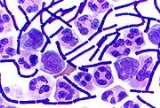
Counterstain
Overview
Staining (biology)
Staining is an auxiliary technique used in microscopy to enhance contrast in the microscopic image. Stains and dyes are frequently used in biology and medicine to highlight structures in biological tissues for viewing, often with the aid of different microscopes...
with color contrasting to the principal stain, making the stained structure more easily visible.
An example is the malachite green
Malachite green
Malachite green is an organic compound that is used as a dyestuff and has emerged as a controversial agent in aquaculture. Malachite green is traditionally used as a dye for materials such as silk, leather, and paper...
counterstain to the fuchsine
Fuchsine
Fuchsine or rosaniline hydrochloride is a magenta dye with chemical formula C20H19N3·HCl. There are other similar chemical formulations of products sold as fuchsine, and several dozen other synonyms of this molecule....
stain in the Gimenez staining technique
Gimenez stain
The Gimenez staining technique uses biological stains to detect and identify bacterial infections in tissue samples. Although largely superseded by techniques like Giemsa staining, the Gimenez technique may be valuable for detecting certain slow-growing or fastidious bacteria.Basic fuchsin stain ...
.
Another example is eosin
Eosin
Eosin is a fluorescent red dye resulting from the action of bromine on fluorescein. It can be used to stain cytoplasm, collagen and muscle fibers for examination under the microscope. Structures that stain readily with eosin are termed eosinophilic....
counterstain to haematoxylin
Haematoxylin
Haematoxylin, hematoxylin, Natural Black 1, or C.I. 75290 is extracted from the heartwood of the logwood tree. When oxidized it forms haematein, a compound that forms strongly coloured complexes with certain metal ions, the most notable ones being Fe and Al salts. Metal-haematein complexes are used...
in the H&E stain
H&E stain
H&E stain, HE stain or hematoxylin and eosin stain is a popular staining method in histology. It is the most widely used stain in medical diagnosis; for example when a pathologist looks at a biopsy of a suspected cancer, the histological section is likely to be stained with H&E and termed H&E...
.
Also in Gram staining
Gram staining
Gram staining is a method of differentiating bacterial species into two large groups ....
, crystal violet
Crystal violet
Crystal violet or Gentian violet is a triarylmethane dye. The dye is used as a histological stain and in Gram’s method of classifying bacteria. Crystal violet has antibacterial, antifungal, and anthelmintic properties and was formerly important as a topical antiseptic...
stains only Gram-positive
Gram-positive
Gram-positive bacteria are those that are stained dark blue or violet by Gram staining. This is in contrast to Gram-negative bacteria, which cannot retain the crystal violet stain, instead taking up the counterstain and appearing red or pink...
bacteria, and safranin
Safranin
Safranin is a biological stain used in histology and cytology. Safranin is used as a counterstain in some staining protocols, colouring all cell nuclei red. This is the classic counterstain in a Gram stain...
counterstain is applied which stains all cells, even allowing the identification of Gram-negative bacteria as well.
Unanswered Questions

